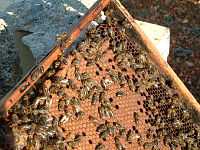Maltese honey bee
| Maltese honey bee | |
|---|---|
 | |
| Maltese honey bees on frame with queen cells | |
| Scientific classification | |
| Kingdom: | Animalia |
| Phylum: | Arthropoda |
| Class: | Insecta |
| Order: | Hymenoptera |
| Suborder: | Apocrita |
| Superfamily: | Apoidea |
| Family: | Apidae |
| Genus: | Apis |
| Species: | A. mellifera |
| Subspecies: | A. m. ruttneri |
| Trinomial name | |
| Apis mellifera ruttneri Sheppard, Arias, Grech & Meixner, 1997 | |
The Maltese honey bee, Apis mellifera ruttneri, is a sub-species of the Western honey bee. It originates from Malta where it is native.
Origin
The bee is a sub-species of the Western honey bee that has naturalized and adapted to the environment of the Maltese Islands. It evolved as a different sub-species when the Maltese islands were cut off from mainland Europe.
Character and behavior
The bee is of relatively black colour. It is well adapted for high temperatures and dry summers and cool winters. Colonies have brood all year round and with good response to the seasons on the islands. They clean the hive well. They tend to swarm or supersede the queen when there are enough stores (generally swarms in Spring and supersedes in Autumn). A very defensive species against wasps, mice and beetles and can be very aggressive against beekeepers and trespassing people. Colonies also have some resistance to Varroa.[1]
History of species
The species is considered as making a comeback after Varroa was introduced to Malta in 1992. At that time colonies of bees from abroad were imported to compensate for the loss of native colonies. In 1997 the species was identified as a sub-species. It breeds well with the Italian sub-species making a strain that defends well against Varroa and has good honey yield, while less aggressive, although this is somewhat endangering the Maltese sub-species as a genetically distinct entity and after some generations it ends up a totally aggressive hybrid.
References
| |||||||||||||||||